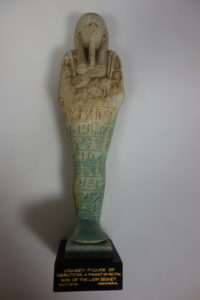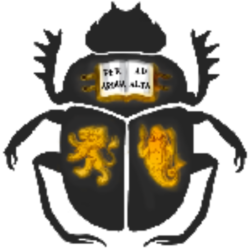The Discovery and Accessioning of the Shabti of Horwedja
Sigrid Nilsson
In ancient Egypt, small figures known as shabtis were placed in tombs from the Middle Kingdom and onwards. These were meant to serve the deceased in the afterlife, taking on the manual labour that he or she was expected to do. What started as one or maybe a couple of wooden statuettes evolved over time into an elaborate group of workers, one for each day of the year. Some would even have an extra overseer for every ten workers, meaning the ultimate number of shabtis in a tomb would be 401. These small, often mummiform, statuettes are often inscribed with the so-called shabti spell, which comes from the Chapter Six of The Book of the Dead. This is the case with the unusually large and fine collection of shabtis from the tomb of Thirtieth Dynasty priest Horwedja (also Horudja or Herutch). One of these, in total 399 figures, belongs to the Eton Myers Collection of Egyptian Antiquities and this essay focuses on that and the stories it can tell us.[1]
Flinders Petrie (1853-1942) was a mainly self-taught Egyptologist, conducting excavations in varying places all across Egypt during the late Nineteenth and early Twentieth centuries. Working on a dig in Hawara, near Faiyum, Petrie discovered, among other things, the tomb of Horwedja, priest of the goddess Neith and son of Seshet. The tomb was flooded, and upon the discovery of the shabti figures, Petrie partly had to climb into the water and dislodge the shabtis with his feet – while surrounded by bones and skulls of the mummies buried there. The find was later catalogued and packed up, spread across museums and collections all over the world.[2] What is so special about this set of shabtis, then?
 © Eton Myers Collection, University of Birmingham |
They are all detailed and more well made than what is usual, especially with such late examples. When the shabti collections in tombs grew into the hundreds, they became smaller and less detailed than they had been. The shabti in the Eton Myers Collection and its brothers are, however, unusually large and well made. This led Flinders Petrie to suppose that they had all been handmade, discerning 17 different styles among them which he wanted to attribute to as many manufacturers. A later criticism of this theory states that it is unlikely that they would have been handmade, if for nothing else then for the fact that there is not a single fingerprint on any of them, something that seems unlikely. The shabti is made of faience, which is malleable and would be fired to achieve its stone like qualities, making the complete lack of signs of human touch rather incredible. Whether handmade or not, it is certain that it is well made and larger than usual for the time.[3]
Like many other shabtis, this has the shabti spell inscribed with hieroglyphs. Nine bands conveying the purpose and the orders of this would-be worker cover the lower half of the mummiform body. This would magically activate the shabti in the afterlife. A translation of the spell follows:
|
He carries the tools with which to work the fields of the afterlife: a hoe, a mattock and a grain basket attached to a rope and flung over his shoulder. The colour of the shabti would originally have been of the characteristic blue-green nuance that Egyptian blue faience holds. Due to the time that the shabti spent underwater, though, that colour has faded almost completely leaving the top half white. The lower half still carries some of the original glazing, though, and it is possible to imagine how impressive in quality, quantity, size, and colour this group of shabtis would have been originally.[4]
Particular for this shabti is the base which was added to the sculpture at some point after Petrie’s find. A large black base which informs the beholder of the owner of the shabti (Horwedja), the place where it was found and to which dynasty it was thought to belong. This base tells us of our own practices when dealing with ancient or other museum objects, and how these have changed over time. Nowadays, it is vital that every object receives its own accession number and is catalogued separately but with connections made to similar objects. The number will often be discreetly written on the object, but no other information will be directly attached to it; a base would not be attached to an object, such as was done to this shabti, as it changes the object from the state it was found in. The problems of insufficient provenance knowledge is clear in the case of the Horwedja shabti, even though the find is well-known enough for the basics of the provenance to be known. Which of the different categories that Petrie divided the shabtis into that this one belongs to is, on the other hand, unknown. He wrote the number of statuettes in each category down, but did not in any way make corresponding marks or labels for the actual figures.[5] The ideology of museum practices, including everything from accessioning to restoration, change over time. The earlier practices and labelling seem to suggest a complete knowledge of the object and its history – such a certainty that they would write it on a base and affix the object onto it. In the case of the Horwedja shabti though, the Twenty-Sixth Dynasty (664-525 BC), as is written on the base, was later reevaluated to be the Thirtieth Dynasty (380-343 BC) – showing the ways in which knowledge is constantly changing. This constant change in interpretation and provenance is what practice today is adapted to. The objects are presented on their own, as found (though often restored), with all information available to access separately so as to allow the changes without changing the object. Thus they will not risk being considered mislabelled in the future. While the identification of the object is no longer written on the object, the registration of provenance is more carefully handled today.
[expand title=”Endnotes”]
[1] Price 2015; Price 2012b
[2] Janes 202: 396-397; Petrie 1890: 8; Aubert and Aubert 1974: 252-255
[3] Janes 2012: 396-399; Aubert and Aubert 1974: 252-255
[4] Janes 2012: 397-399; Price 2012a
[5] Janes 2012: 397-399
[/expand]
[expand title=”Bibliography and Further Reading”]
Aubert, J.F., and Aubert, L. 1974. Statuettes Egyptiennes. Chaoabtis, Ouchebtis. Paris.
Janes, G. 2012. The Shabti Collections 5: A Selection from the Manchester Museum. Cheshire.
Petrie, W.M.F. 1890. Kahun, Gurob and Hawara. London.
Price, C. 2015. ‘“While skulls bobbed on the waves…” Retrieving Horwedja’s shabtis’, in A. Stevenson (ed.), The Petrie Museum of Egyptian Archaeology: Characters and Collections. London: UCL Press, 66-67.
Price, C. 2012a. ‘Texts in translation #7: The shabti spell of Horudja’, Egypt at the Manchester Museum https://egyptmanchester.wordpress.com/2012/07/05/texts-in-translation-7-the-shabti-spell-of-horudja/.
Price, C. 2012b. ‘Why do museums collect… shabtis?’, Egypt at the Manchester Museum https://egyptmanchester.wordpress.com/2012/05/19/why-do-museums-collect-shabtis/.
The Shabti of Horwedja, Eton Myers Collection
http://mimsy.bham.ac.uk/detail.php?t=objects&type=all&f=&s=horwedja&record=0
[/expand]
